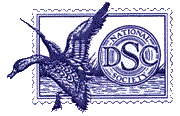 |
National
Duck Stamp |
|
| ||||||
The Art of CollectingPart 1: Research and
Definition Perhaps it's their sheer beauty that first attracted you - a wildlife gallery in miniature! Or are you a hunter turned stamp collector as a result of that stack of licenses you or a relative have saved? Maybe you're concerned with conservation and the environment and realize these stamp funds are dedicated to purchasing wetlands and preserving them for future generations. Or perhaps you have a keen eye for investment potential and have noted that duck stamps have performed extremely well over the years. So how do you collect your duck stamps? Perhaps a basic singles collection of Federal Ducks, mint or used, is your only passion. You may have branched out into plate number blocks or plate number singles, maybe even by number and position. Do you dabble in stamps on license, artist signed, errors or varieties? Then there's First Day of Issue covers and cards, BEP souvenir cards, appreciation cards, Smithsonian FDC programs, and onsite programs, etc. Please don't forget there are 50 states who issue or have issued duck stamps as well, with most of the above specialties pertaining. Let's not forget the international stamps either - a most popular and growing collector area. These mind-boggling options aside, most collectors do first pursue the collecting of mint US Federal Duck Stamps. After all, there are only a finite number of stamps since 1934 with one new addition per year! The primary focus of this article is to pinpoint the "art of collecting" Federal Duck Stamps in their purest mint single form, and to educate and assist you, the collector, as to what grade and condition to purchase and why it is right for you. If you will, let's call it a primer for the novice, a refresher course for those more experienced, but a proven method for personal collecting satisfaction. The first phase of duck stamp collecting (or any collecting for that matter) I define as "Research and Definition." It seems reasonable that before you should do much purchasing, you would want to gather as much information as possible. This might first come in the form of a reference catalog such as the Scott Federal and State Stamp Catalogue ($19.95), which contains full color pictures, designs, artist name, catalog number, and basic price information. Also quite good is The Duck Stamp Collection, sold by the Superintendent of Documents, US Government Printing Office, Washington, DE 20402. For a most extensive treatment of the artwork, designs, and artists, I'd recommend a large "coffee table" book entitled Duck Stamps and Prints ($75 list, but usually discounted). Although these are out of print books, they are sometimes available. Dealer price lists and sales catalogues contain up-to-date information and listings as well as current market prices. A good study of these lists can provide a wealth of information of the market place that regular catalogues cannot cover. Additional sources of information are from the Federal Duck Stamp Office, Washington, DC 20240, from an organization such as NDSCS with its publication Duck Tracks, and occasionally from the regular philatelic press, both newspapers and magazines/journals. Presumably by this time you have read enough to have ample background information. What is now needed is hands-on experience! If you are fortunate, you might know a duck stamp collector who could share viewing his collection with you. Next, if you couldn't visit with one of the nationally recognized dealers who specialize in duck stamps, you could perhaps visit a local dealer who might have a decent duck stamp sampling. A stamp show with several dealers might make an even better venture. The bottom line is to "physically research" the stamps, noting carefully centering, gum quality, color and freshness, and observing the wide range of condition in which these stamps can exist. This "reconnaissance mission" should open up your eyes to the diversity of stamp conditions and propel you into a separate phase of "condition research." I realize this process seems lengthy, but I can assure you from experience that those collectors who do their homework are those who are most pleased with the collections they have built, and derive the most pleasure from them. But remember that up to this point, hypothetically, you have not purchased many stamps. We now enter what I refer to as the "definition process" - selecting what grade and condition exactly suits your particular collecting reasons, budget, and personality. Without doubt, condition plays a critical role in the pricing of Federal Duck Stamps. The accompanying chart is offered as a conservative standard for defining centering and gum quality, verbalizing that which you see. Since grading is a very subjective process, set your own understanding and standards of grading, and without rationalization stay true to it for your entire set of stamps. Purchase stamps of the same grade, as it makes no sense to pursue a set of mixed and varying conditions. Over purchasing wastes dollars, underpur-chasing allows discontent. This is a set of only precious few stamps and they will look better, "feel" better, and be more valuable as a matched set of stamps. Always remember that condition is what should determine the market price of a given stamp, but cost should not be a primary factor in determining which set to build. Remember that cost is a function of time.
Once you've chosen the proper course of action and grade that's right for you - stay with it and don't deviate. A few more suggestions for maximizing your collecting experience:
From Duck Tracks, Third Quarter 1998, Vol. 6, No. 3
|
|